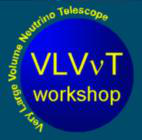Orateur
M.
Francisco Salesa
(IFIC-Valencia)
Description
The ANTARES collaboration has almost completed the construction of an underwater neutrino telescope located at 2500 km depth, 40 km away from the Toulon coast in France. The final detector will consist of 900 photomultipliers (PMTs) distributed in 12 lines. At present, the deployed detector is the largest neutrino telescope in the northern hemisphere. The aim of ANTARES is the detection of cosmic neutrinos. A good angular resolution, which relies on a good time resolution and positioning, is required to identify the neutrino sources. In this contribution, we review the ANTARES time calibration systems, namely: 1) the on-shore dark room calibration, which allows the measurement of the relative time offsets between PMTs, 2) the echo-based clock system, which enables the measurement of the time delay of the signal from the clock board located on each storey to the shore station, 3) the optical beacons which send light pulses that allow the relative time calibration of PMTs, and 4) the K40 calibration which together with the OBs allow a determination of time differences between PMTs of the same storey. These systems have shown that the required time resolution is achieved. Moreover, they ensure that the relative time offsets between PMTs are properly computed, and therefore enable an optimized track reconstruction. The experience gained with ANTARES in the issue of time calibration is of great value in the design of the corresponding system for a VLVNT in the Mediterranean Sea.
Auteur
M.
Francisco Salesa
(IFIC-Valencia)

